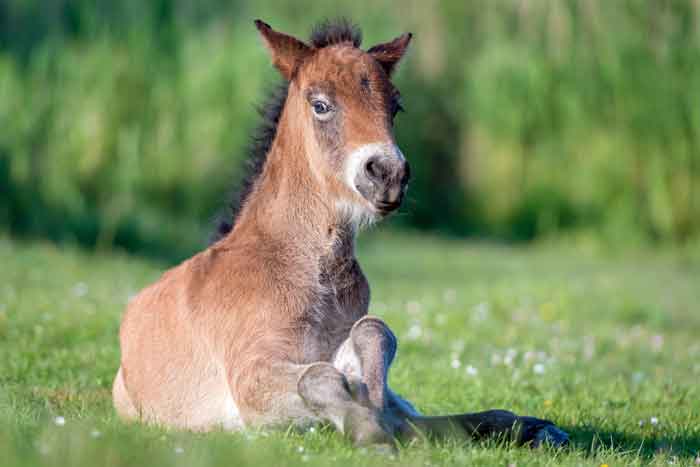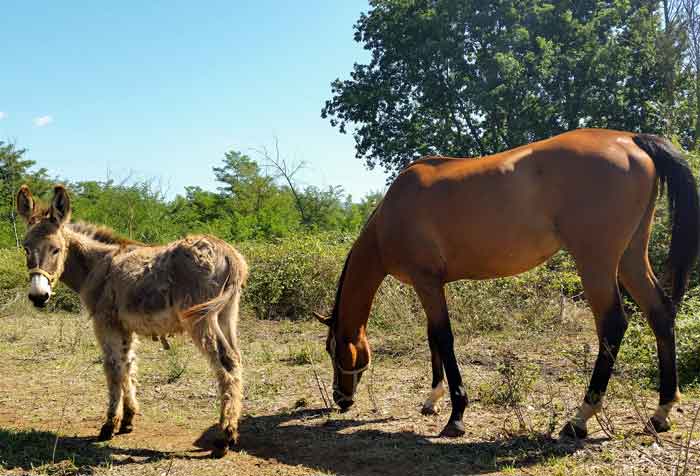Horses can be highly stubborn, and that can get frustrating when you are trying to work with them.
Horses are big animals and can be very hard to work with if they refuse to move or cooperate with you.
Not only can it be hard to get a stubborn horse to run if they don’t want to, but they can also act out in other ways such as bucking, rearing, backing up violently, sometimes they even throw themselves to the ground.
Even if you have a stubborn horse, that doesn’t mean that there aren’t things that you can do to work with them.
With a few training exercises and patient tricks, you should be able to get even a stubborn horse to cooperate.
Table of Contents

8 Ways to Get a Horse to Run:
Getting a horse to run the way that you want him to is important when you are training your horse.
Training a horse to be responsive to you and your touch is something that you will want to make sure you are doing correctly.
1. Find Out Why:
Finding out why your horse is stubborn can help you when moving forward with training for your horse. Horses can be stubborn for a few different reasons.
These reasons can include but are not limited to:
- Laziness
- Lack of Training
- Lack of Faith in their Rider
- Fear of the Unknown
- Lack of a Cue to Move Forward
If you have a better idea about why your horse is refusing to follow commands, you can better work with them to be better working with you.
2. Train to Move Forward:
The first thing that you should be focusing on when you are training your horse is to teach your horse how to move forward at any pace.
Training a horse to go forward, even when he doesn’t want to can help to cure his stubbornness.
Having a “go forward” cue can be essential to getting your horse to move forward when he doesn’t want to.
To teach your horse to move forward, you will want to:
- Make sure to stand on the left side of your horse and hold their lead rope in your left hand.
- Push the lead rope forward with one hand while you tap the horse’s left hip bone with your other hand.
- Continue to do so until he begins to move forward.
- While your horse is walking forward, stop pushing and tapping him, turn him in the direction you want to go, and walk a few strides.
- Pet and run your horse and give him kind words of encouragement.
- Repeat this until your horse starts to know what you are asking from him.
- When you are confident, your horse has learned what you are teaching him, repeat this process on his right side.
One thing that you have to be ready for when trying to get a stubborn horse to move forward is that their first instincts might be to go backward.
Do not let this discourage you and continue to be patient and work with your horse.
Also, make sure that you stay alert when training in case your stubborn horse rears up. If you are not prepared, you can get really hurt if you are in the wrong place in comparison to an agitated horse who is rearing.
3. Deal with Stubbornness Immediately:
If you do not deal with a horse’s stubbornness immediately, they will begin to believe that they are in charge, not you. This is common when training all animals.
You want to make sure that if a horse is not following your commands, you deal with it immediately and take action to change his behavior. If your horse stops moving forward when you are riding him, lean forward and squeeze your legs together from thighs to heels.
This should help to encourage him to move forward.
If this doesn’t work, you can try to lead them from the ground instead.
4. Use Repetition:
Repetition is a great way to teach anything, whether it is to horses, pets, children, or even yourself.
To teach your horse to go faster, you will want to train them using consistent cues to your horse. This cue should be a very reasonable and simple form of contact between you and your horse.
In addition to teaching your horse a cue to go forward, you should also make sure to teach your horse a cue to stop.
It can be very dangerous training a horse to go faster, who does not know how to properly and safely stop with you onboard.
5. Get Warmed Up:
Excercise, no matter who you are, should be gradual. You don’t want to wake up and start your run at an all-out sprint, and neither does your horse.
Warming up is not only good for your horse’s muscles but can also help to get them in the right mood for running.
After you warm-up, you should practice transitioning speeds with your horse as well as working in circles, and other walking patterns.
6. Create a Schedule:
If you do not consistently train your horse, you can lose all the progress that you have made.
To make sure you are staying on track with your horse’s training, you should keep a schedule.
A schedule would not only let you know what to work on with your horse and when, but you can also keep track of your horse’s progress and record it so that you know whether or not there are improvements being made.
7. Make Sure Your Horse is Comfortable:
Comfort is important for your horse. If you are a runner, you know that the right clothes and shoes can make all the difference. This can be similar to your horse.
Most important, when looking at the comfort of your horse is their saddle. Make sure that the saddle is properly fitted and nothing is worn down or broken.
This will help keep your horse comfortable.
If your horse is not comfortable, they won’t want to go faster or even move at all.
8. Proper Diet:
A proper diet is also important for your horse.
This helps their health as well as giving them the energy to be able to move more quickly and have more energy.
If you notice your horse is lagging, when they are usually able to go faster, it could need a better diet, or need more hydration.
How Do You Make a Horse go Faster?
Wanting your horse to go faster is not uncommon. But how do you get them to do it? Besides the list above, there are some other possible techniques you can use to increase your horse’s speeds.
9. Interval Training:
If you have ever tried to run yourself, you know that a good way to increase your speeds and endurance is to alternate running and walking.
After a warm-up, you can alternate between your horse’s trotting pace (which is faster than a walk but slower than a lope or run) to a loping or running pace.
If you break up your horse’s running or loping into manageable chunks, then they will be better able to work on their speed and endurance.
One example of a possible example of a break-up schedule could be one-mile running and then a few miles of trotting. You would alternate until you are finished with your training for the day, including a warm-up and cool down.
Cool-downs can help you reinforce your training as well as allow your horse to recover and reduce the lactic acid build-up in the muscles.
10. Rest:
Proper rest between training is key.
If you wear out your horse and over-do it, they will be less likely to want to go out with you in the future, and you will not see the improvements you are looking for.
Proper rest can also prevent potential injuries to your horse, and it’s joints and muscles.
If your horse gets injured, you will have to take time off from your training, and it could be hard to get your horse back on schedule.
11. Trainer Experience:
If you have tried to train your horse, and you are having a hard time getting results, you could always turn to a professional trainer.
A professional will have more experience working with all types of horses, including the stubborn ones, and could have some techniques that would be able to coax results out of your horse that you are struggling to get yourself.
You could also work with the horse and the professional trainer at the same time, and they can give you some pointers on how to work with your horse and that way you would still get the bonding time with your horse and impart to your horse that you are the one in charge.
Should all horses be able to run fast?
All horses can run fast, but some horses can run faster than others.
Most horses can run between 25-30 miles per hour, but some horses can reach a top speed of 55 miles per hour.
Different breeds are also ideal for different distances. For example, thoroughbreds can maintain their speed for a longer distance while quarterhorses are very fast but suited for shorter distances.
There are a few factors that can help affect a horse’s speed that include but are not limited to:
- The horse’s frame
- The horse’s leg length/stride
- The horse’s muscle fibers
- Whether or not they have a rider, and how big there rider is
Even though there are factors that can affect speed, it doesn’t mean that you can’t help your horse reach their full speed potential through the training techniques listed above, but you still want to be careful.
Don’t push your horse past what they are capable of achieving.
There are genetic and other factors that affect the speed of your horse, and it can be unfair to have expectations for them that they will never meet.






